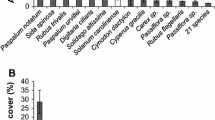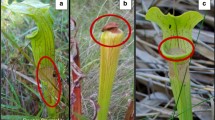Summary
Herbivore effects were studied on populations of the biennial plant species Senecio jacobaea and Cynoglossum officinale. During a three year period (1985–1988) population characteristics (herbivory, number of seedlings, rosettes and flowering plants) were compared in-and outside exclosures, as well as parameters reflecting vegetation cover. In S. jacobaea, a strong negative effect of Tyria jacobaeae was found on seedling establishment, rosette growth and flowering. On the other hand, vertebrate herbivores (mainly rabbits) had an indirect positive effect by limiting the development of the surrounding vegetation (esp. grasses). The increasing vegetation cover in protected populations caused a reduction in germination, seedling- and rosette-growth. Herbivory on C. officinale was low (<10%), no direct effects of herbivores on plant populations were shown. Indirect effects of herbivory through an increasing vegetation were even more pronounced as in S. jacobaea. Therefore, although both plant species may first benefit from herbivore-exclusion, their populations are dependent on rabbits eating other plants (esp. grasses) and reducing competition.
Similar content being viewed by others
References
Belsky AJ (1986) Does herbivory benefit plants? A review of the evidence. Amer Nat 127:870–892
Breemen AMM (1984) Comparative germination ecology of three short-lived monocarpic Boraginaceae. Acta Bot Neerl 33:283–305
Breemen AMM, Leeuwen BH van (1983) The seed bank of three short-lived monocarpic species, Cirsium vulgare (Compositae), Echium vulgare and Cynoglossum officinale (Boraginaceae). Acta Bot Neerl 32:245–246
Brues CT (1946) Insect Dietary. Harvard University Press, Cambridge, Mass
Cameron E (1935) A study on the natural control of ragwort (Senecio jacobaea L.). J Ecol 23:266–322
Cavers PB, Harper JL (1966) Germination polymorphism in Rumex crispus and Rumex obtusifolius. J Ecol 54:367–382
Cox CS, McEvoy PB (1983) Effect of summer moisture stress on the capacity of tansy ragwort (Senecio jacobaea) to compensate for defoliation by the cinnabar moth (Tyria jacobaeae). J Appl Ecol 20:225–234
Crawley MJ (1983) Herbivory. The dynamics of animal-plant interactions. Studies in ecology vol 10. Blackwell Oxford
Crawley MJ (1989) Insect herbivores and plant population dynamics. Ann Rev Entomol 34:531–564
Crawley MJ, Nachapong M (1985) The establishment of seedlings from primary and regrowth seeds of ragwort (Senecio jacobaea). J Ecol 73:255–261
Dempster JP, Lakhani KH (1979) A population model for cinnabar moth and its food plant, ragwort. J Anim Ecol 48:143–163
Ehrlich PR, Birch LC (1967) The ‘balance of nature’ and ‘population control’. Am Nat 101:97–107
Freysen AHJ, Troelstra SR, Kats MJ van (1980) The effect of soil nitrale on the germination of Cynoglossum officinale L. (Boraginaceae) and its ecological significance. Acta Oecol & Oecol Plant 1:71–79
Gibson CWD, Brown VK, Jepsen M (1987) Relationships between the effects of insect herbivory and sheep grazing on seasonal changes in an early succesional plant community. Oecologia 71:245–253
Gross KL (1980) Colonization by Verbascum thapsus of an old field in Michigan: experiments on the effects of vegetation J Ecol 68:919–927
Grubb PJ (1976) A theoretical background to the conservation of ecologically distinct groups of annuals and biennials in the chalk grassland ecosystem. Biol Conserv 10:65–76
Hairston NG, Smith FE, Slobodkin LB (1960) Community structure, population control, and competition. Am Nat 94:422–425
Harper JL (1977) Population biology of plants. Academic Press London
Harper JL, Wood WA (1957) Senecio jacobaea L. In: ‘Biological Flora of the British Isles’ J Ecol 45:617–637
Islam Z, Crawley MJ (1983) Compensation and regrowth in ragwort (Senecio jacobaea) attacked by cinnabar moth (Tyria jacobaeae). J Ecol 71:829–843
Julien MH (1987) Biological control of weeds: a world catalogue of agents and their target weeds. Wallingford, UK: CAB Int 2nd ed
Klinkhamer PGL, Jong TJ de (1987) Plant size and seed production in the monocarpic perennial Cynoglossum officinale L. New Phytol 106:773–783
Klinkhamer PGL, Jong TJ de (1988) The importance of small scale disturbance for seedling establishment in Cirsium vulgare and Cynoglossum officinale. J Ecol 76:383–392
Mattson WJ, Addy ND (1975) Phytophagous insects as regulators of forest primary production. Science 190:515–522
McEvoy PB (1984) Seedling dispersion and the persistence of ragwort Senecio jacobaea (Compositae) in a grassland dominated by perennial species. Oikos 42:138–143
McEvoy PB (1985) Depression in ragwort (Senecio jacobaea) abundance following introduction of Tyria jacobaeae and Longitarsus jacobaeae on the Central Coast of Oregon. Proc VI Int Symp Biol Contr Weeds: 57–64
Meijden E van der (1971) Senecio and Tyria (Callimorpha) in a Dutch dune area. A study on an interaction between a monophagous consumer and its host plant. Proc Adv Study Int Dynamics Number Popul (Oosterbeek 1979):390–404
Meijden E van der (1979) Herbivore exploitation of a fugitive plant species: local survival and extinction of the cinnabar moth and ragwort in a heterogenous environment. Oecologia 42:307–323
Meijden E van der (1990) Mechanisms in plant population control. Symp British Ecol Soc: Towards a More exact ecology, Oxford 1988:163–181
Meijden E van der, Waals-Kooi RE van der (1979) The population ecology of Senecio jacobaea in a sand dune system. I. Reproductive strategy and the biennial habit. J Ecol 67:131–153
Meijden E van der, Bemmelen M van, Kooi RE, Post BJ (1984a) Nutritional quality and chemical defence in the ragwort-cinnabar moth interaction. J Anim Ecol 53:443–453
Meijden E van der, Jong TJ de, Klinkhamer PGL, Kooi RE (1984b) Temporal and spatial dynamics in populations of biennial plants. In: Haeck J and Woldendorp JW (eds) Structure and functioning of plant populations 2. North-Holland, Amsterdam: 91–103
Murdoch WW (1966) ‘Community structure, population control, and competition’ — A critique. Am Nat 100:219–226
Pedersen E (1975) Pyrrolizidine alkaloids in Danish species of the family Boraginaceae. Arch Pharm Chem Sci 3:55–64
Poole AL, Cairns D (1940) Botanical aspects of ragwort (Senecio jacobaea L.) control. Bull NZ Dep Sci Industr Res 82:1–66
Prins AH, Laan RM (1988) Do plant characteristics influence the numbers of Ethmia bipunctella on Cynoglossum officinale? Proc 40th Int Congres on Crop Protection: 1409–1415
Pyke DA (1986) Demographic responses of Bromus tectorum and seedlings of Aropyron spicatum to grazing by small mammals: occurrence and severity of grazing. J Ecol 74:739–754
Room PM, Thomas PA (1985) Nitrogen and establishment of a beetle for biological control of the floating weed Salvinia in Papua New Guinea. J Appl Ecol 22:139–156
Room PM, Harley KLS, Forno IW, Sands DPA (1981) Succesful biological control of the floating weed Salvinia. Nature 294:78–80
Seastedt TR, Crossley DA Jr, Hargrove WW (1983) The effect of low-level consumption by canopy arthropods on the growth and nutrient dyhamics of black locust and red maple trees in the Southern Appalachians. Ecology 64:1040–1048
Verkaar HJ (1988) Are defoliators beneficial for their host plants in terrestrial ecosystems. A review. Acta Bot Neerl 37:137–152
Waloff N, Richard OW (1977) The effect of insect fauna on growth, mortality and natality of broom, Sarothamnus scoparius. J Appl Ecol 14:787–798
Author information
Authors and Affiliations
Additional information
Publication of the ‘Meijendel comité’, New Series no. 108
Rights and permissions
About this article
Cite this article
Prins, A.H., Nell, H.W. Positive and negative effects of herbivory on the population dynamics of Senecio jacobaea L. and Cynoglossum officinale L.. Oecologia 83, 325–332 (1990). https://doi.org/10.1007/BF00317555
Received:
Accepted:
Issue Date:
DOI: https://doi.org/10.1007/BF00317555




